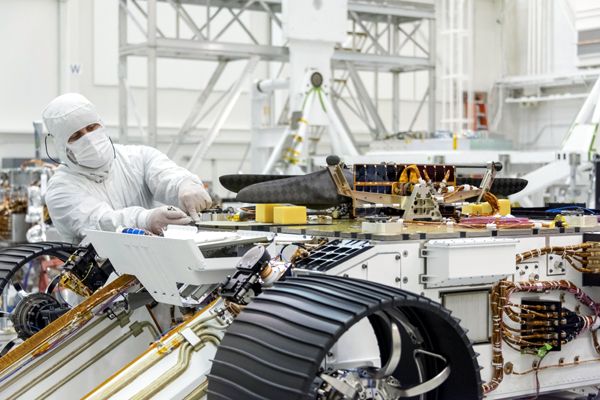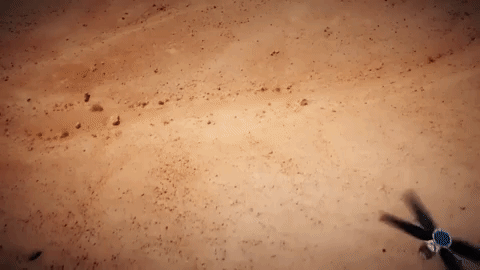
NASA / JPL - Caltech
NASA's Mars Helicopter Attached to Mars 2020 Rover (News Release - August 28)
Engineers attached NASA's Mars Helicopter, which will be the first aircraft to fly on another planet, to the belly of the Mars 2020 rover today in the High Bay 1 clean room at the Jet Propulsion Laboratory near Pasadena, California.
The twin-rotor, solar-powered helicopter was connected, along with the Mars Helicopter Delivery System, to a plate on the rover's belly that includes a cover to shield the helicopter from debris during entry, descent and landing. The helicopter will remain encapsulated after landing, deploying to the surface once a suitable area to conduct test flights is found at Jezero Crater, the rover's destination.
The Mars Helicopter is considered a high-risk, high-reward technology demonstration. If the small craft encounters difficulties, the science-gathering of the Mars 2020 mission won't be impacted. If the helicopter does take flight as designed, future Mars missions could enlist second-generation helicopters to add an aerial dimension to their explorations.
"Our job is to prove that autonomous, controlled flight can be executed in the extremely thin Martian atmosphere," said JPL's MiMi Aung, the Mars Helicopter project manager. "Since our helicopter is designed as a flight test of experimental technology, it carries no science instruments. But if we prove powered flight on Mars can work, we look forward to the day when Mars helicopters can play an important role in future explorations of the Red Planet."
Along with investigating difficult-to-reach destinations such as cliffs, caves and deep craters, they could carry small science instruments or act as scouts for human and robotic explorers. The agency intends to establish a sustained human presence on and around the Moon through NASA's Artemis lunar exploration plans, using the Moon as a stepping stone to putting humans on Mars.
"The Wright Brothers flew the first airplane at Kitty Hawk, North Carolina, but they built it in Dayton," said NASA Administrator Jim Bridenstine. "The Mars Helicopter, destined to be the first aircraft to fly on another world, was built in Pasadena, California. Joined now to the 2020 rover, it is yet another example of how NASA's Artemis generation is expanding humanity's reach in our solar system."
"With this joining of two great spacecraft, I can say definitively that all the pieces are in place for a historic mission of exploration," said Thomas Zurbuchen, associate administrator of the Science Mission Directorate at NASA's headquarters in Washington. "Together, Mars 2020 and the Mars Helicopter will help define the future of science and exploration of the Red Planet for decades to come."
The Mars 2020 rover, with the Mars Helicopter aboard, will launch on a United Launch Alliance Atlas V rocket in July 2020 from Space Launch Complex 41 at Cape Canaveral Air Force Station in Florida. When it lands at Jezero Crater on Feb. 18, 2021, the rover will be the first spacecraft in the history of planetary exploration with the ability to accurately retarget its point of touchdown during the landing sequence.
JPL is building and will manage operations of the Mars 2020 rover and the Mars Helicopter for NASA. NASA's Launch Services Program, based at the agency's Kennedy Space Center in Florida, is responsible for launch management. Lockheed Martin Space provided the Mars Helicopter Delivery System.
To submit your name to travel to Mars with NASA's 2020 mission and obtain a souvenir boarding pass to the Red Planet, go here by Sept. 30, 2019:
https://go.nasa.gov/Mars2020Pass
Source: Jet Propulsion Laboratory
****

NASA / JPL - CalTech

No comments:
Post a Comment